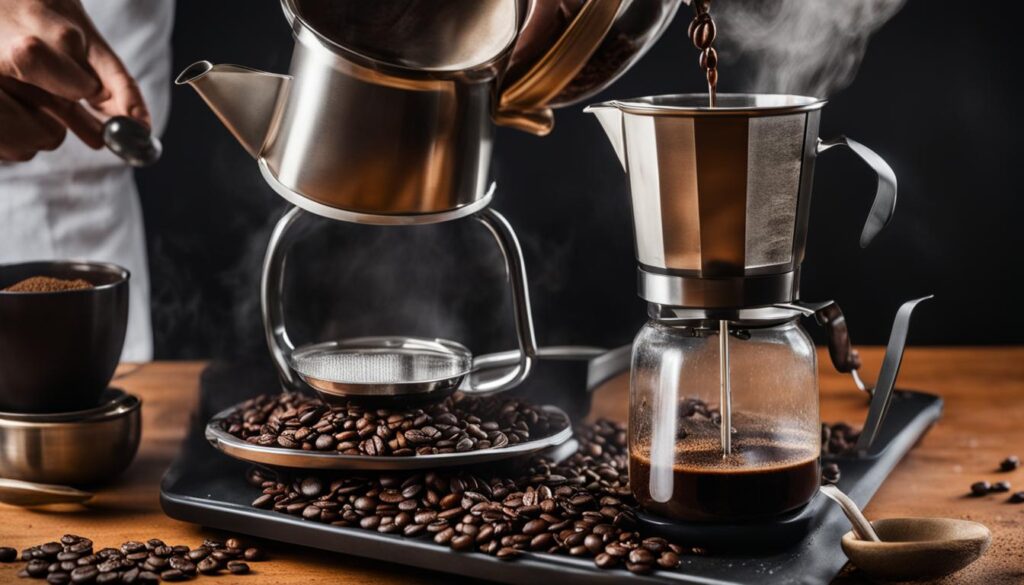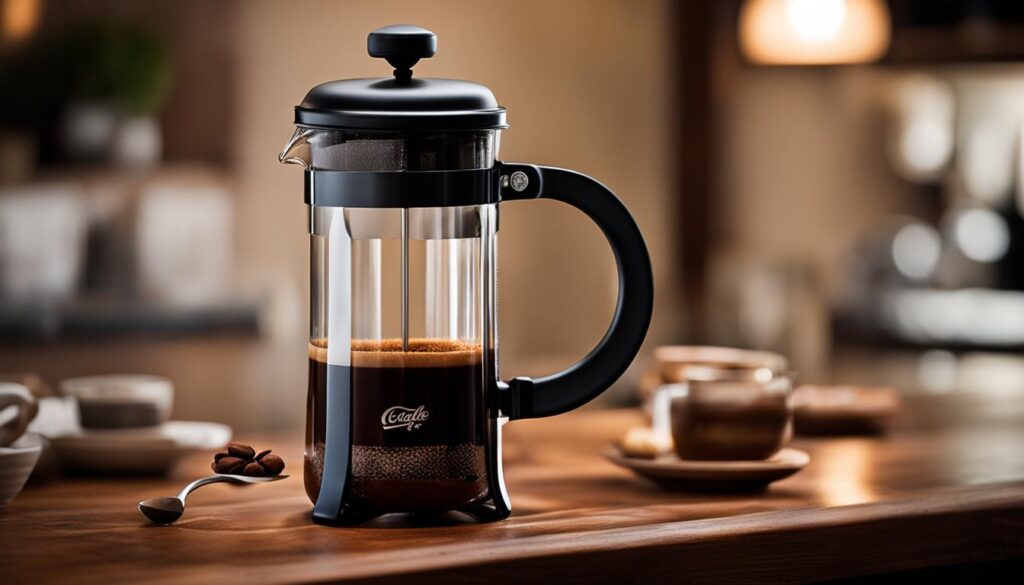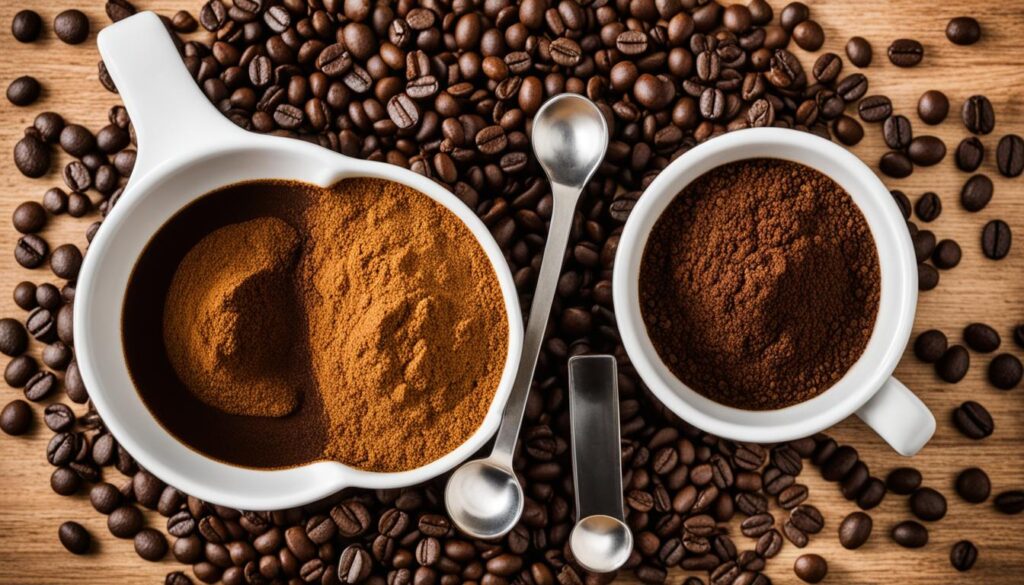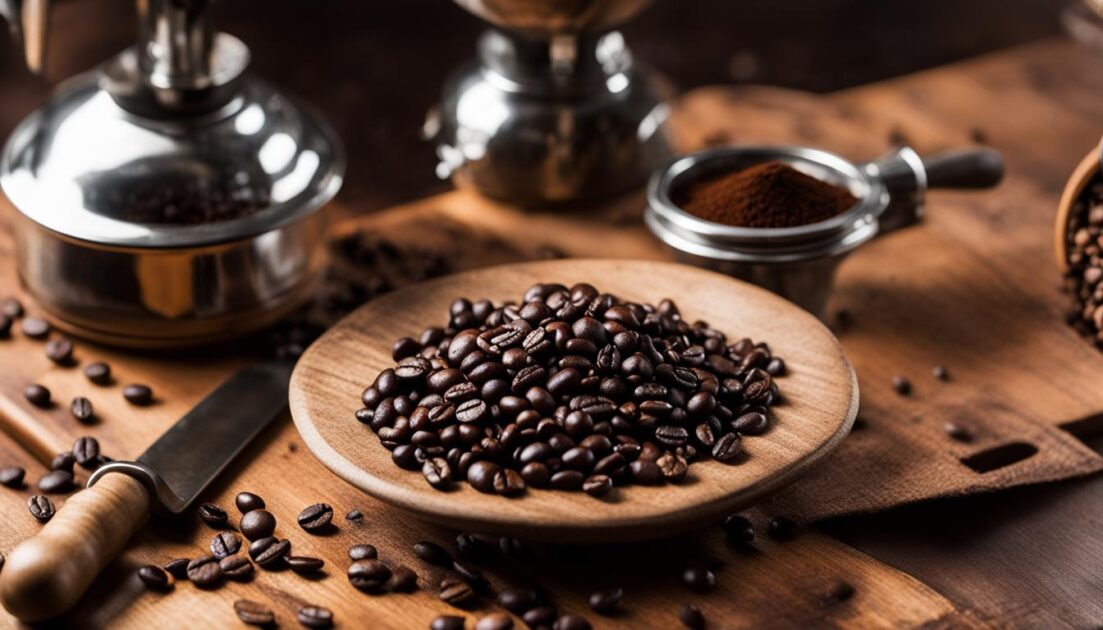For coffee enthusiasts, there’s nothing quite like the aroma of freshly brewed coffee filling the air, signaling the start of a new day or a much-needed break. While there are various methods to brew a cup of coffee, the automatic drip coffee machine remains a favorite. Starting with high-quality, freshly roasted coffee beans and a medium grind, follow a 1:16 coffee-to-water ratio. Place the coarsely ground coffee in the coffee maker’s basket and add cold, filtered water to the reservoir. Turn on the coffee maker and wait for it to complete the brewing process. Once done, pour and serve the freshly brewed coffee into your mug and enjoy!
Key Takeaways:
- Choose freshly roasted coffee beans and grind to a medium consistency for a rich flavor.
- Use cold, filtered water and maintain the recommended coffee-to-water ratio for the best results.
- Experiment with brewing time, techniques, and measurements to find your preferred taste.
- Invest in a burr grinder for a consistent grind size.
- Purchase small amounts of coffee beans regularly and store them properly for maximum freshness.
Choosing the Right Coffee Beans and Grind Size
To make the perfect cup of ground coffee, it is important to choose the right coffee beans and grind size. Start by selecting high-quality, freshly roasted coffee beans that suit your taste preferences. For a brewed coffee, a medium grind is generally recommended, similar to the texture of sea salt.
“Choosing high-quality, freshly roasted coffee beans is essential for a flavorful cup of ground coffee.”
Investing in a burr grinder can greatly improve the consistency of your grind size. Unlike blade grinders, burr grinders grind the coffee beans evenly, resulting in a more uniform extraction and better flavor in the cup.
“Investing in a burr grinder ensures a consistent grind size for a better tasting cup of coffee.”
The Importance of Water and Coffee-to-Water Ratio
When it comes to brewing a perfect cup of ground coffee, the water you use and the coffee-to-water ratio play vital roles in achieving optimal flavor. Let’s delve into the details of why these factors are crucial.
The Water Quality: Filtered Excellence
Using high-quality water is essential for a flavorful brew. If your tap water is not of good quality, I recommend opting for filtered or bottled water. The impurities in tap water can negatively impact the taste and aroma of your coffee. By choosing a purified water source, you give your ground coffee the best chance to shine.
Cold Water for Brewing Brilliance
Did you know that the temperature of the water also affects the taste of your coffee? When brewing ground coffee, it is best to use cold water. The cold water allows for a gradual extraction of flavors, resulting in a smoother and more balanced cup of coffee.
The Golden Ratio: Perfect Balance
Now, let’s talk about the coffee-to-water ratio. The “Golden Ratio” is a general guideline to ensure the right balance of flavors in your cup. It suggests using one to two tablespoons of ground coffee for every six ounces of water. This ratio provides a solid foundation to start with, but don’t be afraid to experiment and adjust the ratio according to your personal preference.
| Coffee-to-Water Ratio | Water (ounces) | Ground Coffee (tablespoons) |
|---|---|---|
| Mild Strength | 6 | 1 |
| Moderate Strength | 6 | 1.5 |
| Strong Flavor | 6 | 2 |
Use this table as a reference to adjust the coffee-to-water ratio based on the strength of flavor you desire. It’s important to find the right balance to unlock the full potential of your ground coffee.
By understanding the importance of water quality and the coffee-to-water ratio, you can elevate your coffee brewing experience and savor the rich flavors that ground coffee has to offer.

Brewing Time and Techniques
The flavor of your brewed ground coffee is influenced by the amount of time the water is in contact with the coffee grounds. Different brewing methods require varying contact times, which can affect the taste profile of your coffee. Experimenting with brewing time allows you to find the perfect balance for your taste preferences.
When using a drip system to brew your ground coffee, the recommended contact time is approximately 5 minutes. This allows the water to extract the desired flavors from the coffee grounds. However, it’s important to note that brewing time may vary based on the specific drip coffee machine you’re using.

On the other hand, if you prefer using a French press to brew your ground coffee, the contact time should range between 2-4 minutes. The steeping process in a French press allows for a stronger and more robust extraction of flavor. It’s worth noting that steeping for longer than 4 minutes may result in over-extraction, leading to a bitter taste.
Understanding the contact time required for your preferred brewing method is essential to achieving the desired flavor profile in your cup of coffee. Remember to consider your personal taste preferences and make adjustments accordingly. The brewing process can be a delightful journey of experimentation and discovery to find the perfect cup of coffee that suits your palate.
Fine-Tuning Your Measurements
Achieving the perfect cup of ground coffee often requires some experimentation. One crucial aspect to focus on is the coffee-to-water ratio. Adjusting this ratio can significantly impact the strength and flavor of your brew. Start by making small increments in your coffee-to-water ratio until you find your desired taste. For instance, if you prefer a stronger brew, increase the amount of coffee while maintaining the same water volume. Conversely, if you prefer a milder taste, decrease the amount of coffee accordingly.
Remember: Fine-tuning your measurements is a personal process, influenced by individual preferences. Keep a coffee journal to record your brewing experiments and document the adjustments made. This journal can serve as a reference guide for future brews, allowing you to recreate your favorite cup of coffee each time.
Coffee-to-Water Ratio Guide
| Coffee-to-Water Ratio | Brew Strength | Taste Profile |
|---|---|---|
| 1:15 | Strong | Intense flavor with pronounced bitterness |
| 1:16 | Medium | Well-balanced flavor with moderate bitterness |
| 1:17 | Mild | Subtle flavor with minimal bitterness |
Discovering the ideal coffee-to-water ratio may require some trial and error, as it ultimately depends on individual taste preferences. Take the time to experiment and find your desired strength and flavor profile.

Tips for the Perfect Brew
Here are some additional tips to help you make the perfect cup of ground coffee.
- Invest in a burr grinder for a consistent grind size.
- Use filtered water for the best taste.
- Avoid letting the brewed coffee sit on the warming plate for too long to prevent flavor decline.
- Clean your coffee maker regularly for optimal flavor and performance.
- If your brew is weak and sour, try a finer grind. If it’s bitter and strong, try a coarser grind.
- Adjust the coffee-to-water ratio and steeping time based on your taste preferences.
Invest in a Burr Grinder for Consistency
A burr grinder is an essential tool for achieving a consistent grind size, which is crucial for brewing the perfect cup of ground coffee. Unlike blade grinders, which can result in uneven extraction, a burr grinder ensures a uniform grind size. This leads to better flavor extraction and a more enjoyable coffee experience.
Use Filtered Water for Optimal Taste
The quality of the water you use can greatly affect the taste of your coffee. To enhance the flavor of your brew, it is recommended to use filtered water. This helps to remove any impurities or minerals that may interfere with the coffee’s flavor profile. By using filtered water, you can achieve a cleaner, more vibrant taste in your cup of freshly brewed coffee.
Don’t Let Coffee Sit on the Warming Plate for Too Long
After brewing your coffee, it’s best to avoid leaving it on the warming plate for an extended period. The longer the coffee sits on the hot plate, the more likely it is to become over-extracted and lose its optimal flavor. To preserve the freshness and taste of your brew, pour it into a thermal carafe or insulated mug as soon as it’s ready.
Regularly Clean Your Coffee Maker
To maintain the best possible flavor and performance from your coffee maker, it’s important to clean it regularly. Over time, mineral deposits, oils, and residue can accumulate in the machine, which can impact the taste of your coffee. Follow the manufacturer’s instructions for cleaning and descaling your coffee maker to ensure optimal flavor extraction and a long lifespan for your appliance.
Adjust Grind Size, Ratio, and Steeping Time
Every coffee enthusiast has different preferences when it comes to the strength and flavor of their brew. If your coffee turns out weak and sour, try using a finer grind size to increase extraction. On the other hand, if your coffee tastes bitter and strong, a coarser grind size can help reduce extraction. Additionally, adjusting the coffee-to-water ratio and the steeping time can also greatly influence the flavor profile of your brew. Experiment with these variables to find the perfect balance that suits your taste.
By following these tips and fine-tuning your brewing process, you can enjoy a consistently delicious cup of freshly ground coffee every time.
The Role of Freshness and Storage
When it comes to brewing ground coffee, freshness is paramount. To ensure the best quality and flavor, it is essential to choose freshly roasted coffee beans and store them properly. Here are some tips for selecting and storing coffee beans:
Choosing Coffee Beans for Grinding
- Opt for coffee beans that have been recently roasted. Look for the roast date on the packaging, and purchase beans as soon as possible after the roast date. This ensures that the beans are at their peak freshness and flavor.
- Consider buying smaller amounts of coffee beans at a time, ideally every one to two weeks. This allows you to enjoy the freshest coffee and prevents the beans from going stale.
- Experiment with different coffee bean varieties and origins to discover your preferred taste profile. From light to dark roasts, each offers a unique flavor experience.
Proper Storage Methods
- Store your coffee beans in an airtight container to protect them from oxidation and moisture. Avoid using clear or transparent containers, as they may expose the beans to light, leading to flavor degradation.
- Ensure that the storage container is kept in a cool, dark place, away from direct sunlight, heat, and humidity. Light, heat, and moisture can accelerate the deterioration of the beans’ flavor.
- Avoid storing coffee beans in the refrigerator or freezer, as frequent temperature fluctuations and condensation can alter the flavor and consistency of the beans.
Remember, coffee beans start losing their flavor and freshness immediately after they are roasted. By purchasing freshly roasted beans and storing them correctly, you can enhance the quality of your brewed ground coffee and enjoy a more satisfying coffee experience.
| Benefits of Freshly Roasted Coffee Beans | Tips for Proper Storage |
|---|---|
| – Enhanced flavor | – Use an airtight container |
| – Aroma preservation | – Store in a cool, dark place |
| – More pronounced acidity | – Avoid direct sunlight and heat |
| – Richer body and texture | – Don’t store in the refrigerator or freezer |
The Joy of Coffee and Personal Preferences
When it comes to making ground coffee, there is no one-size-fits-all method. It’s a personal experience that allows you to explore and discover your own unique taste preferences. While there are guidelines to follow, the right way to make it is the way that brings you the most joy.
Don’t be afraid to experiment with different coffee roasts, origins, and preparation techniques. Try a light roast from Ethiopia and savor its delicate floral and citrus notes. Take a trip to Colombia with a medium roast and enjoy its rich chocolatey flavors. Or explore the dark side with a bold French roast that offers a smoky intensity.
When brewing ground coffee, let your senses guide you. Take the time to inhale the captivating aroma as it wafts through your kitchen. Then, with each sip, savor the intricate flavors that dance on your taste buds. Seek out the brewing techniques and brewing tips that elevate your coffee experience to new heights.
Remember, making ground coffee is more than just a means to an end. It is a journey of self-discovery and a celebration of the rich world of coffee. So, embrace your personal preferences, experiment with different methods, and let the joy of coffee envelop your senses.
FAQ
How do I make ground coffee at home?
Start with high-quality, freshly roasted coffee beans and a medium grind. Follow a 1:16 coffee-to-water ratio, place the ground coffee in the coffee maker’s basket, add cold, filtered water to the reservoir, and wait for the brewing process to complete. Pour and serve the freshly brewed coffee into your mug and enjoy!
What type of coffee beans should I use and what grind size?
Choose high-quality, freshly roasted coffee beans that suit your taste preferences. For brewed coffee, a medium grind similar to the texture of sea salt is recommended. Invest in a burr grinder for a consistent grind size that ensures better flavor in the cup.
How important is the water quality and coffee-to-water ratio?
The water you use plays a crucial role in the quality of your ground coffee. Filtered or bottled water is recommended if your tap water is not of good quality. Cold water is preferred for brewing, and the general guideline is to use one to two tablespoons of ground coffee for every six ounces of water. Adjust the ratio based on your taste preferences.
How does brewing time and technique affect the taste of ground coffee?
The amount of time the water is in contact with the coffee grounds affects the flavor. In a drip system, the contact time should be around 5 minutes, while a French press requires 2-4 minutes of steeping. Different brewing methods have different contact times, which can affect the taste of the coffee. Experiment with the contact time to find the right balance for your preferences.
How can I fine-tune my measurements for the perfect cup?
Adjust your coffee-to-water ratio and grind size to suit your taste preferences. Start by making small increments in your measurements until you find your desired taste. Keeping a coffee journal can help you track and refine your brewing experiments for future brews.
What are some tips for making the perfect cup of ground coffee?
Invest in a burr grinder for a consistent grind size, use filtered water for the best taste, and avoid letting the brewed coffee sit on the warming plate for too long to prevent flavor decline. Regularly clean your coffee maker for optimal flavor and performance. If your brew is weak and sour, try a finer grind; if it’s bitter and strong, try a coarser grind. Adjust the coffee-to-water ratio and steeping time based on your taste preferences.
How important is freshness and storage for ground coffee?
Freshness is key when it comes to ground coffee. Purchase coffee beans as soon as possible after they’re roasted, and aim to buy small amounts every one to two weeks for the best quality. Proper storage is also important to maintain freshness. Avoid reusing coffee grounds, as the desirable flavors have been extracted, and only bitter ones remain. Find ways to recycle the used grounds instead.
Can I make ground coffee according to my personal preferences?
Absolutely! Making ground coffee is a personal experience. While there are guidelines to follow, the right way to make it is how you like it best. Experiment with different roasts, origins, and preparation methods to find your preferred taste. Take the time to enjoy the aroma and flavors in each sip. Making ground coffee is not just about the outcome, but also about the journey of exploration and discovery.






